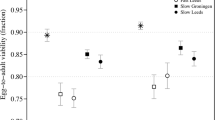Summary
-
1.-
Seven different inbred lines originated from a single wild female have been tested in various environmental conditions.
-
2.-
The inbred lines are shown to be largely different for size and development time as well as for viability.
-
3.-
Reciprocal crosses between these inbred lines, or between these inbreds and a Control line are different for size, development time and viability in certain conditions of temperature and larval diet. The effects of temperature and larval diet on inbreds and hybrids are shown to be very different.
-
4.-
The causes of diversity among the inbred lines are thought to lie partly in nuclear, and partly in cytoplasmic differences. Certain aspects of interaction between these nuclear and cytoplasmic properties are considered, and their theoretical significance discussed.
Similar content being viewed by others
References
Dobzhansky, T. (1950). Genetics of natural populations XIX.—Origin of heterosis through natural selection in populations ofDrosophila subobscura.—Genetics 35: 288–302.
Dobzhansky, T. (1952).Nature and origin of heterosis.—Chapter13, of “Heterosis” edited by J. W. Gowen, Iowa State Coll. Press: 218–223.
Durrant, A. &K. Mather (1956). Heritable variation in a long inbred line ofDrosophila.—Genetica 27: 97–119.
East, E. M. (1908). Inbreeding in corn.Rep. Conn. Agric. Exp. Sta. (1907): 419–428.
East, E. M. (1936). Heterosis.Genetics 21: 375–397.
Fisher, R. H. (1949).The theory of inbreeding, Oliver & Boyd, Edinb. 1–120.
Furtauer, K. (1940). Untersuchungen über die Beziehungen zwischen Photoperiode, Lichtintensität, sowie Temperature und der Plasmavererbung beiEpilobium.—Jahrb. f. wiss. Bot. 89: 412–460.
Gowen, J. W., &L. E. Johnson (1946). On the mechanism of heterosis I. Metabolic capacity of different races ofDrosophila melanogaster for egg production.Am. Nat. 80: 149–179.
Gustafsson, A. (1946). The effeet of heterozygosity on variabillty and vigor.Hereditas,32: 263–286.
Gustafsson, A. (1947). The advantageous effect of deleterious mutations.Hereditas 33: 573–575.
Haldane, J. B. S. (1936). The amount of heterozygosis to be expected in an approximately pure line.Journ. Gen. 32: 375–391.
Heuts, M. J. (1956). Temperature adaptation inGasterosteus aculeatus.—Publ. Staz. Zool. 28: 44–61.
Hull, F. H. (1945). Recurrent selection for specific combining ability in corn.J. Am. Soc. Agric. 37: 134–145.
Jones, D. F. (1945). Heterosis resulting from degenerative changes.Genetics 30: 527–542.
Lerner, M. (1954).Genetic homeostasis. Oliver and Boyd, Edinburgh.
Lerner, M. (1954).The genetic basis of selection, John Wiley, New York.
Lewis, D. (1952). Cytoplasmic heterosis of winter fruiting in tomatoes.John Innes Hort. Inst., Ann. Rep. 12-13.
Lints, F. A. (1960). Nucleo-cytoplasmic interaction inDrosophila melanogaster—Genetica 31: 188–239.
Michaelis, P. (1935). Erhöhte Wachstumintensität und Pilzresistenz durch Plasmavererbung, sowie über die Bedeutung des Plasmas bei Kreuzungsschwierigkeiten.Züchter 7:74–77.
Michaelis, P. (1939). Keimstimmung und Plasmavererbung beiEpilobium.—Jahrb. wiss. Bot. 88:69–88.
Precht, H., J. Christophersen &H. Hensel (1955).Temperatur und Leben. Springer Verlag, Berlin-Göttingen:1–514.
Rasmusson, J. (1934). A contribution to the theory of quantitative character inheritance.Hereditas 18:245–261.
Reeve, E. C. R. (1957). Inbreeding with selection and linkage. I. Selfing.Ann. Hum. Gen. 21:277–288.
Reeve, E. C. R. &J. C. Gower (1958). Inbreeding with selection and linkage II. Sib-mating.Ann. Hum. Gen. 23: 36–49.
Robertson, F. W. (1957). Studies in quantitative inheritance XI. Genetic and environmental correlation between body size and egg production inDrosophila melanogaster.—Journ. Gen. 55:428–443.
Sang, J. H. (1956). The quantitative nutritional requirements ofDrosophila melanogaster.—J. exptl. Biol. 33:45–72.
Shull, A. F. (1912). The influence of inbreeding on vigor inHydatina senta.—Biol. Bull. 24: 1–14.
Shull, G. H. (1914). Duplicate genes for capsule form inBursa bursa-pastoris—Zeitschr. Abst. u. Vererbl. 12:97–149.
Simpson, G. G., A. Roe &R. C. Lewontin (1960).Quantitative Zoology. Harcourt, Brace & Co., New York: 1–440.
Snedecor, G. W. (1946).Statistical Methods, Coll. Press, Ames, Iowa.
Spaas, J. &M. J. Heuts (1958). Contributions to the comparative physiology and genetics of the EuropeanSalmonidae II. Physiologie et Génétique du développement embryonnaire.Act. Hydr. Hydrogr. et. Protistol. 12: 1–26.
Author information
Authors and Affiliations
Rights and permissions
About this article
Cite this article
Lints, F.A. Diversity by inbreeding inDrosophila . Genetica 32, 177–199 (1962). https://doi.org/10.1007/BF01816094
Received:
Issue Date:
DOI: https://doi.org/10.1007/BF01816094




